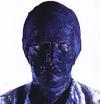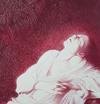Press and Media
The Irish Times – February 16, 2000
The Irish Times
THE BLOODSTAINED FÜHRER
The controversial work of Austrian artist Gottfried Helnwein, now resident in Ireland, explores the lingering Austrian loyalty to Nazism. He speaks to Mic Moroney.
The reaction of many Austrian artists to Jörg Haider's electorial success have bemused the international Austrian artist, Gottfried Helnwein, now resident in Ireland. "I am amazed that they start now, because things were worse in the past. The former Freedom Party leader was Friedrich Peter, who spent four years in an SS company in Russia, where he was involved in exterminating Jews and Communists. That was well documented, but he would always say, 'I do not remember'."
Helnwein is an interesting quantity: a tall, earnestly cheerful, black-clad character, his face often obscured by shades and an overgrown 1970s hairstyle; a deeply moral artist who brings high craftsmanship to his gloomy, visceral drawings and huge photorealist canvases. Obsessed with images of children, often subjected to cruel medical experiment, he has long been a controversial protest artist against Nazism and repressive Catholicism in Austria and Germany, where he insists the two traditions are inextricably linked.
His earliest aktions were traumatised-looking street performances in which, say, he lay bandaged on the sidewalk, studiously ignored by passing Viennese. Yet, until the late 1970s, he had never heard of Viennese Activists, who were frequently jailed in the 1960s for self-mutilation, debauch, or portentous animal slaughters which Hermann Nitsch still enacts in his castle outside Vienna. However, in recent years, Helnwein has exhibited alongside them, and indeed the senior figure of Arnulf Rainer - for Helnwein, "probably the most important Austrian artist."
Helnwein was born in 1948 into a "Middle-middle class" Viennese home and had a strict Catholic education. "I always knew that something was really wrong, but when I asked my parents' generation any questions, I never got any answers."
The truth was that, although under Allied control until 1955, Austria was never properly denazified. In school, Helnwein learnt nothing of the mass exultation at the annexation of Austria, or the jeering Viennese crowds who watched Jews scrubbing the streets with water mixed with acid. "In school, we only heard the one thing over and over, that Austria was Victim Number One of Adolf Hitler, which of course is a joke."
He skipped school, and entered the Experimental Institute for Higher Graphic Instruction. "It was the time of the Beatles and the Stones, and everybody wanted to have a little bit longer hair, close to the ears, but not touching. But walk on the street like that, and people would scream "Hitler should come back and gas you!" This was an ordinary thing to hear, from older people, or construction workers, who would throw stones at us."
He was expelled from the institute - after painting a portrait of Hitler with his own blood - and attended the Academy of Fine Arts - "the same academy that threw Hitler out three times, probably one of the biggest mistakes ever, yeah?" Interestingly, Helnwein studied under the only professor in the Academy whose work was not abstract - Rudolf Hausner, one of the early post-war Viennese symbolist painters.
Helnwein's first exhibition at Vienna's Kunstlerhaus - watercolours of wounded children - was totally defaced by stickers which read Entartete Kunst - the Nazi term for degenerate art. His next exhibition in Modlin was confiscated by police, at the behest of the local mayor. Helnwein made a Hitler painting in oils "in the manner of Third Reich official painting, and always showed this painting with the wounded children. But more people would shake my hand, almost with tears in their eyes, saying "that (Hitler painting) is a great painting, it's about time people started painting real things like that, here's my card, please contact me." I could have sold it 100 times.
"I was once in the Academy working on a quiet Sunday. And this young guy of maybe 20 years peeked in and said, "I'm looking for the painter who painted the Führer!" The painting was leaning against the wall, and I swear, he went down on his knees in front of it, saying, "The Führer, the Führer, it's fantastic!"
Helnwein made his name through cover art for Austrian magazines, provocatively tackling issues like the appointment of Dr Heinrich Gross as Head of State Psychiatry in 1979. "In an interview, he was asked if he had killed hundreds of children in mental hospitals" - under the Nazi euthanasia programme - "and he said, 'yes it is true but at the time, it was a different reality. Today I wouldn't do it.' The guy asked him 'did you inject them?' And he said, 'no, we just mixed the poison in the food, so they weren't aware of what was going on, so they died humanely'.
"This was in one of Austria's biggest newspapers, Kurier, and there was not even one reaction. Meanwhile, 3,5000 people wrote angry letters to ORF" - Austrian State Television - "because for the first time in Austrian history, a presenter appeared without a tie. It was absurd. I thought maybe people couldn't read anymore, that was the problem. So I painted them a picture."
His photorealistic painting of a girl-child slumped in a plate of food, helped start a debate which led to Gross' resignation.
Helnwein left Austria in 1985 "because of many feelings. I was born there, all my family was there, it's my language, but I never felt Vienna was my home. Vienna has a great cultural tradition, but the atmosphere was so horrible, I felt if I continued to live there, I would either become a terrorist or die."
He settled in comparatively liberal Cologne for a decade. One piece of public art he did in 1988 - funded fully by himself, after he failed to raise sponsorship - commemorated the 50th anniversary of Kristallnacht. "Again, what amazed me was that nobody talked about it - and yet that was when the horror really started."
"I wanted to do it in front of the Dome in Cologne, but the City prevented it. But there was this little strip of land which belonged to the railways, and a guy who worked there said, 'go ahead'. I didn't want to use these historic photographs which are used too often - those mountains of corpses mean nothing anymore - so I used four metre high children's faces. I photographed children from the area, foreign children, German children, Jews, anything."
Mounted in a long billboard line, after the huge word "Selection", the children's faces were powdered in a deathly, bruised way, many with their eyes closed. That may sound subtle, but in the context of muted German Holocaust memorials, it was like a slap in the face. Despite CCTV video-cameras, someone painstakingly sliced the throats of every single child-portrait.
He rages at the later murders of children in Solingen, near Cologne, where young neo-Nazis - "16-year-oldss!" - burnt a house full of Turks: "One woman was standing in the window upstairs, holding her child and people were watching her, and she jumped down and died, but the child in her arms survived. I went to the hospital and photographed this child. Her face was destroyed, and she was not even aware that her mother was dead."
Shortly afterwards, Helnwein bought a castle outside Clonmel which he says, along with his wife, Renate and four kids, "gave me, for the first time in my life, a feeling of home". He is currently in Florida, working on a one-man show for London's Robert Sandelson Gallery, involving poignant teratological child images from an Austrian medical museum; and another one-man show at the Modernism Gallery in San Francisco.
In October, he mounts a big retrospective a the Chinese National Museum in Beijing, where he will become the first western artist to show in the Forbidden City, in the Temple of the Ancestors. "The ceilings are 50 metres high, so I want to make big children's faces. 10 metres high around the halls. I hope the censors don't find anything too shocking in that."
http://www.gottfried-helnwein-interview.com/
http://www.helnweinreviews.com/links.htm


